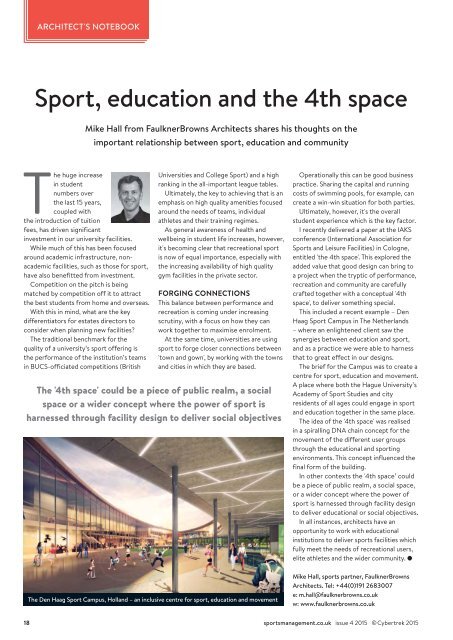EDDIE IZZARD
SM_issue4_2015
SM_issue4_2015
Create successful ePaper yourself
Turn your PDF publications into a flip-book with our unique Google optimized e-Paper software.
ARCHITECT'S NOTEBOOK<br />
Sport, education and the 4th space<br />
Mike Hall from FaulknerBrowns Architects shares his thoughts on the<br />
important relationship between sport, education and community<br />
The huge increase<br />
in student<br />
numbers over<br />
the last 15 years,<br />
coupled with<br />
the introduction of tuition<br />
fees, has driven significant<br />
investment in our university facilities.<br />
While much of this has been focused<br />
around academic infrastructure, nonacademic<br />
facilities, such as those for sport,<br />
have also benefitted from investment.<br />
Competition on the pitch is being<br />
matched by competition off it to attract<br />
the best students from home and overseas.<br />
With this in mind, what are the key<br />
differentiators for estates directors to<br />
consider when planning new facilities?<br />
The traditional benchmark for the<br />
quality of a university’s sport offering is<br />
the performance of the institution’s teams<br />
in BUCS-officiated competitions (British<br />
Universities and College Sport) and a high<br />
ranking in the all-important league tables.<br />
Ultimately, the key to achieving that is an<br />
emphasis on high quality amenities focused<br />
around the needs of teams, individual<br />
athletes and their training regimes.<br />
As general awareness of health and<br />
wellbeing in student life increases, however,<br />
it's becoming clear that recreational sport<br />
is now of equal importance, especially with<br />
the increasing availability of high quality<br />
gym facilities in the private sector.<br />
FORGING CONNECTIONS<br />
This balance between performance and<br />
recreation is coming under increasing<br />
scrutiny, with a focus on how they can<br />
work together to maximise enrolment.<br />
At the same time, universities are using<br />
sport to forge closer connections between<br />
'town and gown', by working with the towns<br />
and cities in which they are based.<br />
The '4th space' could be a piece of public realm, a social<br />
space or a wider concept where the power of sport is<br />
harnessed through facility design to deliver social objectives<br />
The Den Haag Sport Campus, Holland – an inclusive centre for sport, education and movement<br />
Operationally this can be good business<br />
practice. Sharing the capital and running<br />
costs of swimming pools, for example, can<br />
create a win-win situation for both parties.<br />
Ultimately, however, it's the overall<br />
student experience which is the key factor.<br />
I recently delivered a paper at the IAKS<br />
conference (International Association for<br />
Sports and Leisure Facilities) in Cologne,<br />
entitled 'the 4th space'. This explored the<br />
added value that good design can bring to<br />
a project when the tryptic of performance,<br />
recreation and community are carefully<br />
crafted together with a conceptual '4th<br />
space', to deliver something special.<br />
This included a recent example – Den<br />
Haag Sport Campus in The Netherlands<br />
– where an enlightened client saw the<br />
synergies between education and sport,<br />
and as a practice we were able to harness<br />
that to great effect in our designs.<br />
The brief for the Campus was to create a<br />
centre for sport, education and movement.<br />
A place where both the Hague University’s<br />
Academy of Sport Studies and city<br />
residents of all ages could engage in sport<br />
and education together in the same place.<br />
The idea of the '4th space' was realised<br />
in a spiralling DNA chain concept for the<br />
movement of the different user groups<br />
through the educational and sporting<br />
environments. This concept influenced the<br />
final form of the building.<br />
In other contexts the '4th space’ could<br />
be a piece of public realm, a social space,<br />
or a wider concept where the power of<br />
sport is harnessed through facility design<br />
to deliver educational or social objectives.<br />
In all instances, architects have an<br />
opportunity to work with educational<br />
institutions to deliver sports facilities which<br />
fully meet the needs of recreational users,<br />
elite athletes and the wider community. ●<br />
Mike Hall, sports partner, FaulknerBrowns<br />
Architects. Tel: +44(0)191 2683007<br />
e: m.hall@faulknerbrowns.co.uk<br />
w: www.faulknerbrowns.co.uk<br />
18<br />
sportsmanagement.co.uk issue 4 2015 © Cybertrek 2015


